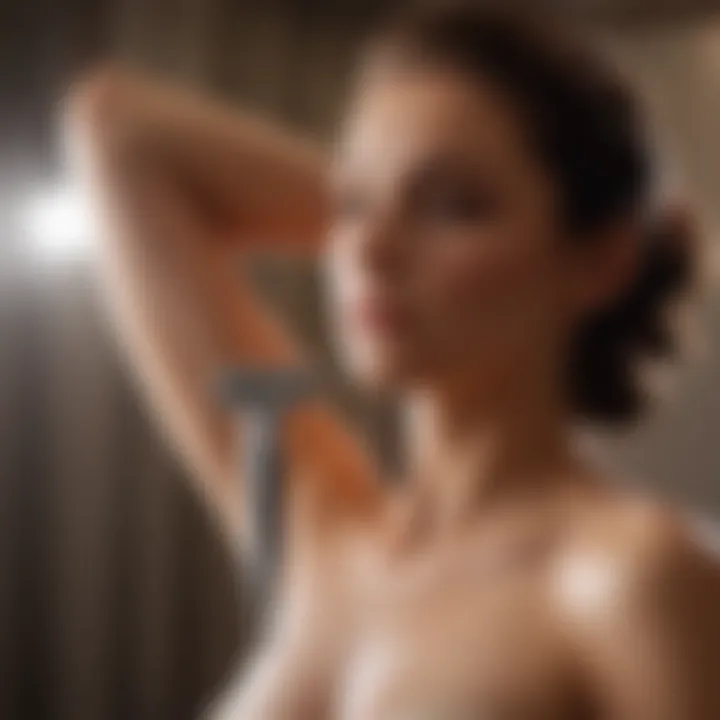How to Shave Your Underarms Properly: A Complete Guide


Intro
Proper grooming of one's body is integral to personal hygiene and style. Among the various aspects of grooming, underarm shaving carries its unique set of challenges and techniques. The skin in this area is sensitive, and improper shaving methods can lead to irritations or other skin-related issues. This guide will explore the key techniques necessary for effectively shaving underarms, focusing on skin preparation, product selection, shaving methods, and aftercare.
By equipping yourself with the right information, you can enhance this part of your grooming routine and maintain a comfortable experience. Whether you are shaving for aesthetics, comfort, or hygiene, understanding the best practices can make a significant difference.
Importance of Underarm Grooming
Grooming underarms is not just about appearance; it also plays a role in personal confidence and social interactions. Many men find that maintaining their underarms leads to a fresher feeling, especially during warm weather. Additionally, proper grooming can prevent body odor and promote a more hygienic lifestyle.
However, this grooming practice can be overlooked. Lack of knowledge about effective techniques may lead to undesired results such as irritation or skin breakouts. It is essential to view underarm shaving not as a chore but as an opportunity for self-care.
"Proper shaving habits can greatly minimize skin irritation and enhance your comfort."
Selecting the Right Tools
When it comes to shaving your underarms, the right tools make all the difference. Here are some recommendations:
- Razor: Choose a sharp, high-quality razor designed for sensitive skin. Multi-blade razors often provide a closer shave, reducing the number of strokes needed.
- Shaving Cream or Gel: Use a hydrating shaving cream or gel that suits your skin type. Look for products that are free from harsh chemicals and fragrances.
- Moisturizer: A soothing aftershave lotion or natural oil will help combat dryness after shaving.
These tools are crucial for a successful shave without irritating the skin. Investing in quality products typically results in a better experience.
Preparing Your Skin for Shaving
Preparation is key to a smooth shaving process. Before you begin, consider these steps:
- Cleanse: Start with a warm shower to cleanse your underarms. This will help soften the hair and open the pores, making shaving easier.
- Exfoliate: Use an exfoliating scrub or a gentle loofah to remove dead skin cells. This can help prevent ingrown hairs later.
- Apply Shaving Cream or Gel: Generously apply your chosen product to create a lubricated barrier between the skin and the razor.
Taking these preliminary steps will ensure that the razor glides easily over the skin, reducing the risk of cuts or irritation.
Shaving Techniques
Once you prepare your skin, it is time to start shaving. Follow this systematic approach:
- Angle the Razor: Hold the razor at a 30-degree angle to the skin. This will help the blade cut the hair effectively without causing too much drag on the skin.
- Shave in the Direction of Hair Growth: Begin by shaving in the direction the hair grows. This method minimizes irritation and reduces the chances of ingrown hairs.
- Use Light Pressure: Let the weight of the razor do the work. Avoid pressing down too hard, as this can cause nicks and cuts.
After the first pass, you may wish to go against the hair growth for a closer shave if necessary. Remember to rinse the blade frequently to remove hair and cream buildup.
Post-Shave Care
After shaving, caring for your skin is essential. Follow these recommendations:
- Rinse with Cool Water: This helps close the pores and calm the skin.
- Apply Moisturizer: Use a fragrance-free aftershave lotion or natural oils such as coconut or almond oil to hydrate the skin and alleviate any irritation.
- Avoid Deodorants Immediately: If possible, wait a few hours before applying deodorants, especially those with strong fragrances or alcohol content, to avoid further irritation.
Practicing proper post-shave care enhances your grooming routine and helps maintain skin health in the long term.
End
Shaving your underarms may seem like a simple task, but mastering the right techniques and care can lead to significant improvements in both comfort and appearance. By understanding the importance of preparation, selecting the right tools, and following effective shaving practices, you can achieve a clean and comfortable finish. With dedication to these methods, underarm grooming can become a seamless part of your routine, allowing you to embrace a polished and confident you.
Understanding Underarm Hair and Its Growth
Understanding underarm hair and its growth is essential for effective grooming. Men who focus on fashion and style should recognize that underarm hair is not merely cosmetic but has biological functions and is influenced by multiple factors.
The growth of underarm hair plays a role in regulating the body’s temperature and reducing friction between the skin surfaces. Additionally, it can have social and cultural implications that influence grooming practices. Focusing on this aspect can lead to a better appreciation of why shaving underarms is often necessary for personal hygiene and comfort.
The Biological Function of Underarm Hair
Underarm hair, or axillary hair, serves primarily as a natural barrier. Initially, it may help trap scent, which can attract potential mates. The presence of underarm hair may also play a role in thermoregulation, helping to maintain the temperature in warm environments. Some scientists believe that the hair may function in a similar skin protection role as on other parts of the body, albeit to a lesser extent.
When discussing shaving, it’s crucial to consider that the removal of underarm hair can alter some of these functions. However, aesthetic preferences usually take precedence in modern grooming habits. Shaving underarms becomes about comfort, cleanliness, and style, which often outweigh the biological roles of the hair.
Factors Influencing Hair Growth
Several factors influence the growth of underarm hair. Genetics play a significant role in determining the density and color of hair. A person's ethnic background may also influence hair growth patterns, with some individuals experiencing sparser hair than others.
Hormones significantly affect hair growth; during puberty, the increased levels of androgens can stimulate the growth of underarm hair. Age is another consideration, as hair growth may decrease with time due to hormonal changes.
Environmental factors like nutrition and health also impact hair growth. A well-balanced diet that provides essential vitamins and minerals may promote healthy hair, while certain medical conditions can hinder growth.
Understanding underarm hair and its growth equips individuals with knowledge to make informed decisions about grooming habits.
The Importance of Proper Shaving Techniques
Shaving underarms is not just a routine task; it requires careful consideration of technique and tools. Proper shaving techniques significantly enhance the quality of the shave and ensure overall skin health. When done correctly, shaving can eliminate irritation, reduce the risk of ingrown hairs, and promote a cleaner appearance. Conversely, improper techniques can lead to numerous issues, including cuts, razor burn, and prolonged skin sensitivity.
Understanding the nuances of shaving is essential for maximizing comfort and achieving desired results. Developing a systematic approach to shaving allows individuals to avoid common pitfalls and embrace a more confident grooming routine. Proper techniques not only serve aesthetic purposes but also contribute to the maintenance of skin integrity over time.
Avoiding Common Mistakes
One of the biggest challenges when shaving underarms is falling into common mistakes that can lead to negative outcomes. Here are some key points to avoid:


- Shaving without Preparation: Failing to cleanse and prepare the skin can result in irritation. Always wash the area thoroughly before shaving.
- Using Dull Razors: Dull blades tug at hair rather than cutting cleanly, which can cause nicks and irritation. Always opt for a sharp, quality razor for an effective shave.
- Skipping Shaving Cream or Gel: Shaving without a lubricant increases the likelihood of razor burn. Always apply a suitable shaving cream or gel to create a protective barrier.
- Rushing the Process: Taking your time is crucial. A rushed shave often results in missed spots or cuts. Methodically shave in the direction of hair growth for best results.
“Patience and process are vital in achieving a smooth, irritation-free shave.”
Avoiding these mistakes can make a noticeable difference in the outcome. Good shaving practices cultivate not only a better appearance but also an improved skin condition.
Benefits of Proper Shaving
When shaving underarms correctly, the benefits extend beyond mere aesthetics. Here’s what proper shaving can offer:
- Reduced Irritation: With the right tools and techniques, the risk of irritation diminishes. This fosters a more comfortable experience and healthier skin.
- Long-Lasting Results: Clean and proper shaving leads to smoother skin for more extended periods. Optimal shaving can extend the time between hair growth cycles.
- Improved Confidence: A well-executed shave enhances personal grooming and contributes to an overall polished appearance. Many find that good grooming increases self-esteem.
- Better Skin Health: Proper shaving promotes better skin maintenance. Using suitable products helps to hydrate and nourish, leading to improved skin texture.
Tools Required for Shaving Underarms
Understanding the right tools for shaving underarms is essential for achieving a smooth and irritation-free result. Different tools serve distinct purposes in the shaving process. By investing time and resources into selecting the right equipment, you not only enhance your grooming routine but also prioritize the health of your skin.
Choosing the Right Razor
The razor you choose can significantly influence your shaving experience. A quality razor can provide a closer shave with less potential for cuts and irritation. It is advisable to opt for a razor with multiple blades, as they tend to glide better over the skin. Additionally, consider whether you prefer a manual razor or an electric one. Each has its own advantages. Manual razors offer greater control, while electric ones can save time.
In selecting a razor, pay attention to the handle design. An ergonomic handle facilitates a more comfortable grip, minimizing the risk of slipping. Some razors even come with moisture strips that can hydrate your skin as you shave, further reducing irritation. It's worth exploring brands like Gillette or Schick for quality options that are well-reviewed by users.
Aligning with Quality Shaving Creams and Gels
The choice of shaving cream or gel is equally vital. A quality product hydrates the skin, softening hair and making the shaving process smoother. Look for creams and gels that contain soothing ingredients, such as aloe vera or chamomile. These elements can help reduce the risk of irritation or inflammation.
When applying, ensure you spread the cream evenly across the area. This not only helps in protecting the skin but also creates a lubricated surface for the razor to glide over. Avoid using products that contain alcohol, as they can dry out the skin and lead to discomfort post-shave. Brands like NIVEA and Edge offer several good options that cater to sensitive skin types.
Additional Products for Enhanced Care
Beyond the primary shaving tools, incorporating additional products can greatly enhance your shaving routine. Using a pre-shave oil can create an extra layer of protection for your skin. It can soften hair and provide added moisture, which can be beneficial, especially for those with coarser hair. Look for natural oils like coconut or argan oil, which can nourish the skin.
After shaving, consider using aftershave balms. These products are designed to soothe and hydrate the skin, preventing the burning sensation some may experience after shaving. Opt for balms that are free from harsh chemicals. A well-known product, like NIVEA Aftershave Balm, can offer excellent results. It is essential to find a routine that works best for you, considering your skin type and personal preferences.
"Choosing the right tools is the first step towards achieving a smooth underarm shave and caring for your skin effectively. Always prioritize quality to avoid unnecessary irritations."
In summary, having the right tools is crucial for a proper underarm shaving routine. A good razor, appropriate shaving cream or gel, and additional care products can elevate your shaving experience and maintain skin health.
Preparing Your Skin for Shaving
Shaving is more than just running a razor over hair. Preparing your skin for shaving is crucial. This process can significantly impact your comfort level, the quality of the shave, and the overall look of your skin afterward. When you prioritize skin preparation, you reduce the risk of irritation, razor burn, and ingrown hairs. Thus, this section focuses on how to prepare the skin effectively for a smooth shaving experience.
Cleansing the Area Properly
Before any shaving takes place, cleansing is essential. This step removes sweat, dirt, and bacteria from the skin’s surface. Use a gentle, unscented soap or body wash. Avoid products with strong fragrances or harsh chemicals, as these can irritate sensitive skin.
To cleanse your underarms:
- Wet the area with warm water. This opens the pores, making hair removal easier.
- Apply a small amount of soap and work it into a lather.
- Massage the lather into the skin, focusing on the areas where you plan to shave.
- Rinse thoroughly to ensure no soap or residue remains.
Cleansing not only prepares the hair and skin but also sets the foundation for the next steps in your shaving routine.
Exfoliation Techniques
Exfoliation is another important step often overlooked. This technique involves removing dead skin cells that can clog hair follicles and contribute to ingrown hairs. Regular exfoliation can also promote better product absorption and a smoother shave.
For effective exfoliation:
- Use a gentle scrub or a loofah once or twice a week.
- Alternatively, a washcloth can work if you apply slight pressure while cleansing.
- Focus on the underarm area by gently buffing the skin in circular motions.
Exfoliating before shaving helps create an even surface, reducing the chances of the razor pulling at the hair, which can lead to irritation.
Hydration and Moisturization Ahead of Time
Hydration is key to preparing your skin. Well-hydrated skin is more elastic, making it easier to shave without discomfort. Hydrating the skin creates a protective barrier, reducing the impact of the razor on sensitive skin.
To ensure your skin is well-hydrated:
- After cleansing and exfoliating, apply a moisturizing lotion or oil to the area. This adds moisture to the skin.
- Allow the moisturizer a few minutes to absorb before applying shaving cream.
Remember, properly prepared skin not only leads to a closer shave but also contributes to the overall health of your skin.
"Taking time to prepare your skin can be the difference between a comfortable, smooth shave and an irritated, unpleasant experience."
Instituting these preparation techniques may seem simple, but they constitute an essential foundation for effective shaving. With the right preparation, you can enhance your shaving routine and maintain healthier skin.
The Shaving Process: Step by Step
Understanding the shaving process is crucial for achieving effective and safe underarm hair removal. Each stage plays a significant role in reducing irritation and enhancing the overall outcome of shaving. Proper execution will not only leave the skin smooth but also help prevent common issues such as razor burn and ingrown hairs.
Applying Shaving Cream Evenly


Applying shaving cream evenly is an essential step in the shaving process. This product creates a protective barrier between the skin and the razor, providing a smoother glide for the blade. To achieve the best results, begin by taking a small amount of shaving cream in your palm or directly from the container. Rub it between your hands to warm it slightly before applying it to the underarm area. This warmth can help activate the ingredients which may provide further comfort while shaving.
Make sure to cover the entire area thoroughly, using circular or back-and-forth movements to ensure an even layer. An adequate amount of cream helps in softening the hair and preparing the skin, making the shaving process easier and more effective. A tip to remember is to look for creams specifically formulated for the sensitive skin of the underarms. These often contain soothing agents that reduce the risk of irritation.
Shaving Techniques for Optimal Results
Using the right shaving techniques can greatly enhance the quality of the shave. It is advisable to use a sharp and clean razor to minimize irritation. A dull blade can lead to tugging and pulling, making the experience uncomfortable.
When shaving, always use short, light strokes. Start at the top and work your way down, following the direction of hair growth. This method helps in reducing the chances of ingrown hairs. Avoid pressing too hard; let the razor do the work. If necessary, rinse the blade frequently. Keeping the razor clean ensures that it remains effective and reduces the likelihood of clogged follicles.
Additionally, adjust the angle of the razor to find the most comfortable position. Each person's skin and hair texture may differ, so experimentation will lead to discovering personal preferences.
Post-Shave Clean Up
Post-shave clean up is equally important as the preceding steps. After shaving, rinse the underarm area with cool water. This not only helps to remove any remaining shaving cream but also cools the skin down after the shaving process. Pat the skin dry gently with a soft towel, avoiding any aggressive wiping that could lead to irritation.
Following the dry-off, consider applying an alcohol-free aftershave product. This type of product soothes the skin and helps in minimizing redness and post-shave discomfort. Look for ingredients like aloe vera or chamomile, known for their calming properties.
Ensuring cleanliness in both your tools and skin will contribute to a better overall shaving experience and less risk of irritation.
Through correct application of these steps, one can see not only the benefits of a good shave but also a significant drop in common shaving-related issues. Therefore, the focus on the shaving process is not just about achieving a smooth appearance; it’s equally about fostering healthy skin.
Post-Shaving Care for Your Underarms
After you have completed the shaving process, the area requires careful attention. Proper post-shaving care can enhance skin health, reduce irritation, and prevent long-term issues. This section delves into the essential practices that ensure your underarms remain smooth and irritation-free after shaving.
Taking time to nurture the skin can significantly impact how you feel and how your skin looks. Many men often overlook this step, thinking the job is done. However, the skin is sensitive after removal of hair, and neglect may lead to complications like soreness or infection.
Applying Aftershave Products
After shaving, it is important to apply aftershave products that are designed specifically for sensitive areas like the underarms. These products often contain soothing ingredients that help calm the skin.
- Choose a suitable aftershave: Look for options that contain ingredients like aloe vera or chamomile. These substances have natural soothing properties which can help ease discomfort.
- Avoid alcohol-based products: Alcohol can dry out the skin and exacerbate irritation. Instead, select a non-alcoholic aftershave balm or lotion.
- Apply gently: Use a clean finger or a cotton pad to apply the aftershave. This minimizes the risk of introducing bacteria to freshly shaved skin.
Addressing Irritation and Sensitivity
Even with the best techniques, some men may experience irritation post-shave. It is crucial to recognize how to manage this sensitivity effectively.
- Cold compress: Applying a cold compress can help reduce swelling and minimize redness. This is especially useful if the skin feels inflamed.
- Avoid tight clothing: Choose looser fabrics, allowing the area to breathe. Tight clothes can lead to chafing and worsen inflammation.
- Use topical treatments: Products containing hydrocortisone cream can help relieve irritation. However, consult with a professional before using medication to ensure it is suitable for your skin.
Long-term Skin Care Maintenance
Maintaining healthy skin requires a consistent approach. Implementing long-term care practices will improve the resilience of the skin in the underarm area.
- Regular exfoliation: This removes dead skin cells, reducing the chances of ingrown hairs forming in the future. Aim to exfoliate the area at least once a week.
- Hydration: Keep the skin moisturized daily. A good moisturizer will help in maintaining the skin’s barrier and prevent dryness.
- Healthy lifestyle choices: Adequate hydration and a balanced diet impact overall skin health. Foods like leafy greens and nuts support skin elasticity and promote healing.
"Caring for your skin does not end once the shaving is done; it requires a commitment to ongoing health and maintenance."
Managing Common Shaving Issues
Shaving underarms is not without its challenges. Understanding these common issues can help in achieving a smooth shave and in maintaining skin health. Addressing these problems not only enhances the shaving experience but also reduces discomfort. Awareness and proper techniques can make a significant difference in your grooming routine.
Dealing with Ingrown Hairs
Ingrown hairs occur when hair grows back into the skin instead of rising above the surface. This can lead to red bumps or even infection. To minimize the risk of ingrown hairs when shaving your underarms, consider the following:
- Exfoliation: Regularly exfoliating the underarm area removes dead skin cells. This helps hair to grow out properly without getting trapped.
- Shaving Techniques: Use a sharp razor and shave in the direction of hair growth. Shaving against the grain increases the risk of ingrown hairs.
- Moisturizing: Keeping the skin well-moisturized can soften hair and skin, reducing the chances of hair becoming trapped.
Adopting these practices can nourish your skin and significantly reduce the occurrence of ingrown hairs.
Preventing Razor Burn
Razor burn is characterized by redness, irritation, and a burning sensation on the shaved area. It can be uncomfortable and unsightly. To prevent razor burn on your underarms, implement the following actions:
- Softening the Hair: Always shave after showering when the skin and hair are soft.
- Use Quality Products: A good shaving cream or gel provides lubrication, reducing friction. Avoid soaps that can dry the skin out.
- Avoid Repeated Strokes: Limit the number of passes over the same area. Repeated strokes can irritate the skin and increase the likelihood of razor burn.
Applying these techniques can lead to a more comfortable shaving experience, ensuring your skin remains smooth.
Avoiding Allergic Reactions
Some individuals may experience allergic reactions to certain shaving products. Symptoms can include redness, itching, or even hives. To avoid allergic reactions:
- Patch Testing: Always conduct a patch test before trying a new shaving cream or post-shave product.
- Choose Hypoallergenic Products: Select products labeled as hypoallergenic, especially if you have sensitive skin or a history of allergic reactions.
- Read Ingredients: Pay attention to the ingredients list of shaving creams and after-shave products. Some ingredients can cause irritation or allergic responses.
By taking these precautions, you can ensure that your shaving routine is safe and effective.
"Managing common shaving issues is essential for skin health, comfort, and an overall positive grooming experience."
By incorporating these practices into your routine, you not only maintain flawless underarms but also protect your skin from irritation and unwanted conditions.
Alternative Hair Removal Methods


Underarm hair removal can be approached in several ways, each having its own pros and cons. While shaving is a common choice, alternatives like waxing, depilatory creams, and laser treatments deserve discussion. Understanding these methods can help you make informed decisions based on your skin type and personal preferences.
Each method offers different benefits and considerations. It is crucial to evaluate these options to find what aligns best with your grooming habits and the results you seek. Here, we focus on three notable alternatives to traditional shaving, elaborating their respective advantages and disadvantages that may suit your individual needs.
Waxing Pros and Cons
Waxing involves applying a sticky substance to the desired area and removing hair from the root by quickly pulling it away. The key benefits include:
- Long-lasting results: Hair takes longer to regrow compared to shaving since it is extracted from the root.
- Reduced thickness of hair: Over time, waxing can lead to finer hair regrowth, making it less noticeable.
- Exfoliation: Waxing can provide the added benefit of exfoliating the skin, resulting in a smoother appearance.
However, there are also some drawbacks:
- Discomfort: The process can be painful, especially for those new to it.
- Skin irritation: Sensitive skin may react negatively, leading to redness or bumps post-waxing.
- Frequency: Depending on hair growth cycles, waxing may need to be done every few weeks, making it more time-consuming than the occasional shave.
Depilatory Creams and Their Efficacy
Depilatory creams are chemical-based products that dissolve hair at the surface level. The ease of use is a notable advantage. These creams offer:
- Convenience: Quick application, usually in the comfort of your home.
- Pain-free: Does not involve pulling hair out from the root, making it suitable for sensitive skin.
- Smooth finish: Can leave the skin feeling soft after use.
Nonetheless, there are considerable concerns:
- Chemical sensitivity: Some may experience allergic reactions or irritation due to the ingredients.
- Shorter results: Hair will regrow faster than with waxing or shaving since it is not removed from the root.
- Odor: Some depilatory creams have a strong chemical odor that may be off-putting.
Laser and Electrolysis Considerations
Laser and electrolysis hair removal methods offer lasting solutions but require careful consideration:
- Laser Hair Removal: This method uses laser technology to target and destroy hair follicles. Benefits include:Disadvantages include:
- Electrolysis: A method that uses electrical currents to destroy hair follicles. Key points:Yet, it comes with:
- Long-lasting results; however, multiple sessions are often needed.
- Suitability for larger areas, making it practical for underarms.
- Treatment can be costly compared to other methods.
- Requires a licensed professional for safety and effectiveness.
- Effective for all hair types and skin tones.
- Permanent hair removal can be achieved with sufficient sessions.
- Cost and time commitment, as each hair is treated individually.
- Potential for temporary discomfort.
Ultimately, the best method for underarm hair removal depends on your lifestyle, budget, and skin type. Research and possibly seek professional advice to determine which option aligns with your grooming priorities.
Cultural Perspectives on Underarm Grooming
Understanding the cultural perspectives on underarm grooming is vital for a complete appreciation of shaving practices. The way underarm hair is viewed differs by region, age, and personal preferences. For many men, underarm grooming has become an integral part of their overall style and self-care routine. Emphasizing grooming goes beyond aesthetics; it reflects personal values, societal norms, and a deeper connection to identity.
Historical Context of Underarm Hair Removal
The history of underarm hair removal is rich and varied. In ancient Egypt, for instance, hairlessness was often associated with cleanliness and societal status. Egyptians used various means to remove body hair, including tweezers made from seashells. In Greco-Roman cultures, similar practices became popular. Here, well-groomed bodies symbolized strength and purity, particularly for athletes participating in the Olympics.
During the 20th century, particularly in Western societies, societal perceptions shifted significantly. The introduction of mass-produced razors changed grooming habits. Advertisements in the early 1900s began to promote the idea that smooth underarms were a standard of beauty. This development not only influenced women's grooming practices but also created additional pressures around male grooming. Thus, today's attitudes towards underarm hair reflect decades of evolving cultural narratives and beauty standards.
Modern Trends in Grooming Habits
In contemporary society, grooming habits have transformed, becoming more individualized. Men now have access to various grooming tools tailored to their needs. There is a growing trend towards hair removal in more urban and fashion-conscious communities. Influencers on social media often highlight the importance of well-groomed underarms as a component of personal style.
Indeed, modern habits often lead to diversified approaches regarding cosmetic products. For example, brands like Gillette and Nivea offer specialized shaving creams and aftershave balms targeted towards men. Solutions for skin hydration and irritation are part of this evolution. The conversation around grooming now includes skincare, mental wellness, and self-expression. Understanding these trends enables individuals to make informed choices regarding their grooming routines.
Embracing cultural perspectives on underarm grooming allows individuals to reflect personal values and societal norms, enhancing their grooming practices.
Ultimately, being aware of cultural practices can enrich one's approach to grooming. Fashion-conscious individuals who are aware of historical contexts and current trends are likely to foster a more thoughtful and confident grooming routine. This comprehensive view not only improves personal style but also deepens connections with societal values and self-identity.
Engaging with regional differences and historical transformations leads to informed decisions in personal grooming and broader implications for everyday life.
Finale: Refining Your Shaving Routine
Shaving underarms is not just about obtaining a cleaner appearance; it involves a thoughtful approach that affects skin health and comfort. In this article, we have explored various facets of this grooming practice, from selecting the right tools to implementing proper post-shave care. Each aspect is essential, which influences the final outcome of your shaving routine.
The Significance of a Tailored Shaving Routine
Refining your shaving routine can lead to multiple benefits. Firstly, it helps in minimizing skin irritation, which is a common concern for many individuals. By adopting specific techniques and using suitable products, you can significantly reduce redness and discomfort after shaving.
Moreover, a well-established routine leads to more consistent results. When you understand what works best for your skin, the process becomes efficient and effective. If you combine good shaving practices with regular skin care, you will likely notice healthier skin over time. This is especially important for the sensitive underarm area, which can be prone to various issues.
Customization According to Skin Type
Each person's skin is unique. Therefore, tailoring your shaving routine is crucial. Individuals with sensitive skin may benefit from non-alcoholic aftershaves, while those with thicker hair might require a more robust shaving cream. Understanding your specific skin type allows you to avoid unnecessary irritation and achieve a smoother finish.
"Choosing the right products and techniques tailored for your skin can lead to a more satisfying shaving experience."
Continuous Evaluation
It is important to regularly assess your shaving routine. If you find persistent issues such as ingrown hairs or razor burn, re-evaluate your products and techniques. Trying different brands and methods can help you discover what works best for you.
Overall, refining your shaving routine is an ongoing process. With dedication and proper care, you can achieve a comfortable and effective shaving experience that enhances your overall grooming regimen.
Final Thoughts on Personal Grooming
Incorporating these strategies into your grooming routine not only elevates your personal care but aligns with broader fashion trends that value meticulousness and sophistication.















